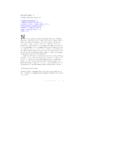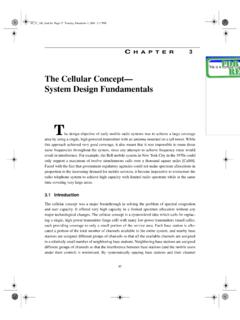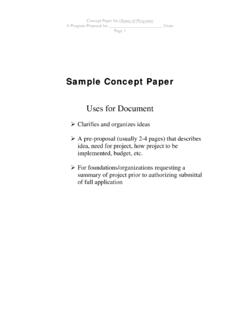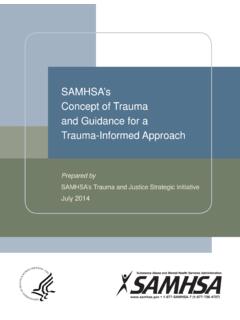Transcription of A Recirculating Aquaculture System (RAS), A Design Concept
1 A Recirculating Aquaculture System (RAS), A Design Concept Building a Recirculating Aquaculture System (RAS) is basically about water quality control. In response to the many who have asked "what does it take to make a typical System ", we have put together a Design proposal for a complete, fully featured status monitoring and control System which we designed to meet the needs of a 4 tank commercial Aquaculture farming facility. This System consists of a set of basic components we have found to be the most often specified for a four tank installation (three grow out tanks and one make up tank). This System is a purely hypothetical Design as each situation is unique and must be designed to suit the individual needs of the customer.
2 Pricing will vary accordingly. The typical System : In essence, it consists of two subsystems: the product tanks, and all the support systems. Product tanks are, naturally, for the product; shrimp, cod, mahi-mahi (my favorite), oysters, you name it. Each has it's own requirements, and that will determine what support systems are required. For arguments sake, let's say its fish. It always amazes me how fish can grow freely, and to a large size, in a backyard pond. But grow them in a tank, and you've opened a bag of worms, as they say. What you're really trying to replicate is an ecosystem; that's what a pond is. So let's generalize a bit and explore a typical RAS, or Recirculating Aquaculture System .
3 Main product tank requirements: In most situations, the fish will require circulating water. This helps keep the tank clean, and more importantly, it eliminates dead spots. Dead spots are areas where the water quality can go out of tolerance, either anerobic or areas where the DO (dissolved oxygen) is too low for the fish to survive, or where the temperature is out of whack. So the tank has to have either an internal pump System , using small direct immersion pumps, or use the equivalent of a water jet from the main Recirculating pumps (the preferred method, usually lower cost). Water quality has to be measured in the tanks to provide alarms, when things do go south, to control the oxygen, temperature ph and other parameters, and in some cases to satisfy food quality requirements.
4 Sensors typically include temperature, pH, and DO. In some systems, especially with high throughput, a common monitoring point feeding several tanks can be used, reducing instrument cost. Outflow: Usually, tanks employ some sort of standpipe to control the tank level. This serves two purposes: it keeps the level at a constant setpoint, and it prevents the tank from running dry. Support equipment: Typically, these include: water filters, including various scrubbers, rotary drum filters, sand filters, etc.`. sterializers, including UV light, O3 (ozone) injection and high temp pasturizers and heat exchangers. In many cases, ORP is also used as a measure of water quality, especially where O3 injection is used.
5 Heating and cooling systems, to maintain water temperatures. Water makeup System , using fresh water, or salt water. If salt water, it is usually manufactured on-site. These typically use conductivity probes to monitor salinity as well. Air blowers (with inlet filters) and O2 injection systems, to maintain DO. Air pressure switches are often used to make sure the air distribution System is functional. In some cases LOX systems are used for supplying O2. CO2 injection systems to maintain pH levels (or other pH. control systems). These also use CO2 mass flow sensors to monitor System health and CO2 Dewars and valves to control CO2 Nutrient injection System , or feeders.
6 And, of course, the primary pump System , including level controls on the tanks Depending on the product, other monitor and control systems may include Light monitoring (PAR or other), light control (lamps, shade cloth control, etc.) which may also be tied into the temperature controls. This list is not inclusive. Other sensors and controls are only limited by specific System requirements, imagination and most of all, by budget . The Controller: MCU500. Each configuration of four tanks uses one MCU500 and an expander box. The MCU 500 is the System controller and comes complete with 8 dual channel analog signal interface modules (16 Input channels) and 8 quad channel digital input cards installed.
7 The expander houses a general purpose signal connection block for wiring out to the sensors, level detectors and other functions. The expander also contains a relay module for controlling up to 16 relays a 12 VDC power supply for providing power to external sensors and line amplifiers, Ethernet interface modem, fan and a fibergralss water tight NEMA 4 enclosure with see-through front panel. The MCU 500 is a plug and play device. No programming We provide a complete set of tools to create the MCU's database and to communicate with the MCU to configure it and control it from your desk top. You configure it by creating a database, describing each channel, alarm functions, setpoints, etc.
8 You can implement timers to control feeders, set points to control pH, DO, aerators, lights, heaters, ventilators, shade cloth, whatever. We will assist you in creating it. There is literally an unlimited combination of sensors and controls that the MCU System can support. Each MCU can be configured with more than one expander unit, increasing the total number of Logical channels up to the maximum of 61 per MCU, up to 256 analog channels, up to 256 Relay control points, up to 64 digital inputs and 64 digital outputs. Within these constraints virtually any combination of sensors and controls can be added, including salinity, photometers, level detecors, control of valves, ORP, ozone and pH control.
9 You can implement alarms from simple two state alarms to more sophisticated five state alarms and prioritize them based on type of alarm, time of day and any parameter you wish to monitor. Each alarm state may be mapped to a specific function, , turn on/off a pump, etc. The MCU also has a very powerful yet easy to use script language which lets you create functions and process control routines as you need them. We also provide desk top tools to communicate with the MCU (by modem, Ethernet, direct serial, SMS. and CDMA cell modems, and more. It's very internet friendly and can be managed from anywhere in the world, securely.)
10 The software packages provide automated data capture and display tools giving you the capabilities you need to best run your facility. The MCU may also be controlled from your PC. You can operate the MCU from the convenience of your office or home, including reading System perameters, operating switches, setting setpoints, alarm points. The MCU is designed for stand-alone operation, and may be configured to take whatever action is required in the event of alarms automatically. For record keeping, the MCU data logging output is fully configurable as a *.cvs format, and importable& into all common spreadsheet programs.








